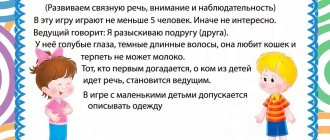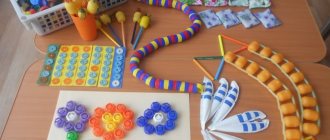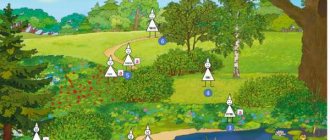Short games to stimulate a child's speech
Unfortunately, some parents do not attach importance to the child’s speech development, and later to the child’s delay in speech development, they try not to pay attention, and hope that “everything will go away on its own.” The “norms” for speech development have shifted significantly over the past few decades.
It is imperative to pay attention to the child’s speech. The least we can do is play simple and quick games with our child every day. Here is an example of these games.
- Pebbles. The child throws small pebbles and large beads into the water, making a sound like “glug-glug.”
- Indians. The child pronounces the sound a-a-a loudly and protractedly, clapping his hand on his lips.
- Ball. The child throws up a balloon with the sound “Uh”.
- Hedgehog. A child sticks matches and needles with the words “kol-kol-kol” into the molded hedgehog.
- Nails. The child “hammers nails” by hitting the buttons hard with a hammer and saying the sound “Bang.”
- Live sounds. "Hockey! “- the child waves the “stick” with the sound “xxxx”; “locomotive” - sharply unclenches his fists with the sound “pppppp”; “lid on the teapot” - taps his fist with his palm “bbbb”; “rain” - taps his fingers on the table “k-k-k”; “watch” - the finger swings in different directions: tut-tut; “pump” - puts his hands in lock, bends over with the sound “ssssssssssssssssssssssssssssssssssssssssssssssssssssssssssssssssssssssssssssssssssssssssssssssssssssssssssssssssssssssssssssssssssssssssssssssssssss."
For children 1 – 2 years old
At the age of 1 to 2 years, children, as a rule, already try to imitate the speech of adults. Kids have the following skills:
- Ability to repeat open syllables. For example, they will not be able to pronounce the word “give” clearly, but the sound “dya” is familiar to our ears.
- There is a repetition of sounds and syllables - imitation of animals.
- Expressing emotional state through intonation.
- Some objects and actions can be denoted using syllables.
- Catch and perceive adult speech. Ability to point to objects.
Parents not only need to competently construct speech statements, pronounce words correctly and clearly when addressing their child, but it is also important to competently plan and organize children’s leisure time, and exercises for speech development in children 1–2 years old will help you with this.
Children who cannot yet stand or walk independently will need adult help. These games will not only have a beneficial effect on the baby’s speech ability, but will also strengthen the muscles of the body.
Games - nursery rhymes
Taya, shake your hands, (Shak your hands) And also wave your palms. (Waving) Fingers hid in fists. (Hide our fingers) We'll put our fists in barrels. (we clasp our hands into fists to our sides) Stomp our feet. (We stomp) Let's clap our hands. (Clap) Let's stamp with our right foot. (Stamp) Let's stamp with our left foot. (Let's stomp) And let's go and dance in a squat, like a flock of goslings. (We walk on our haunches) We stomp our feet like this (We stomp) Top - stomp, stomp - stomp. So let's clap our hands (Clap) Clap - clap, clap - clap. So let's shake our heads Oh - oh, oh - oh. This is how we lift our legs (Raise our legs) High - high. This is how we lower the legs (Lower the legs) Low - low. This is how we lift our arms (Raise our arms) High - high. This is how we lower the handles (Lower the handles) Low - low.
Crow - magpie (we move along the baby’s palm) Cooked porridge, fed the kids. I fed this one (Bend my thumb) I fed this one (Bend my index finger) I fed this one (Bend my middle finger) I fed this one (Bend my ring finger) But I didn’t feed this one! (Slightly shake the little finger) He was a small finger and behaved like a limp one.
My friend, quickly my friend, (Imitate making a snowball) Throw me your snowball! (Throw a snowball) I catch it quickly (Catch a snowball with my hands) And roll it quickly (Roll a snowball) Look at the bullfinches (Look around)
Their breasts are the reddest of all. (Stroke ourselves on the chest) One, two, three, four, five. We go out into the forest for a walk. (We walk in place) Let's look around. (We look around) A good bear is walking there. (We point with our hand to the side) You are a little bear, wait, (We call the bear with both hands) Take us with you into the forest. Feed me some sweet honey! Little finger, where are you going? (Touch the little finger) You’re wandering past with this brother! (Touching the nameless one) With this, you enter a dense forest. (Touch the middle one) With this you walk in the meadow, (Touch the index finger) You call together gray ducks. With this, he ran past (Touching the big one) And ran into the ditch. (Draw between thumb and index)
Read more: Personality psychology: child from 8 to 11 years old
Finger - boy - mischievous. (We stretch our fingers one by one) Where did you suddenly come from? I visited the brothers. I rested there with grace. With this we go fishing, With this we dance in circles, With this we run in the morning, With this we always have fun.
Simple exercises
Children who are just learning to pronounce sounds will benefit from special exercises for speech development, which should be given 15 to 20 minutes a day:
1. Show kids how to express emotions with sounds.
- Surprise: “OH!”
— Dissatisfaction: “AY – YAY!”
- Disappointment: “AH!”
2. While playing hide and seek, change the pitch of your voice.
While in another room, make a sound: “AU” at first quietly, then louder and louder. The little one will quickly understand the rules of the game and try to repeat after you.
3. When using any objects, clearly pronounce their names.
4. Let your child drink liquids using a straw. This promotes the development of the articulatory apparatus.
5. Let your baby experience toys of different textures: hard, soft, wet, wet dry, fluffy, smooth.
6. Praise your child if he tries to interact with older kids.
7. Play a round table game with your children. Collect all your child’s favorite toys and feed them, saying the following words:
— How does a dog ask you to eat? "AB - AB."
- Let's feed the dog. How does a dog eat? "OM-NOM-NOM".
Logorhythmic chants “Beetles”, “Sly Fox”, etc. At this age, children especially like them and are easy to remember. And in combination with melody and characteristic movements, they develop the speech center and coordination.
Find the parts of the case
All children under three years of age should know all parts of the body. Playing with a doll will help kids remember, or you can show body parts on yourself and ask the child to repeat. At the same time, it is important not to lose sight of the sides: right, left; directions: below, above.
Sample of an educational song for kids “Left-Right” in the video:
Short speech games-poems
Hedgehog
A hedgehog walks with a drum: Boom-bom! (2p) The hedgehog plays all day: Boom-bom! (2p) With a drum behind your shoulders: Boom-bom! A hedgehog entered the garden by accident: Boom-bom!
A hedgehog can walk with different tools or objects: a bell - ding, a telephone - trrrrr, a rattle - trin, etc.
Hippopotamus
It comes from the swamp: “aaaaaaa!” The menacing voice of a hippopotamus: “aaaaaa” He guards the swamp: aaaaaaa He sings in a menacing voice: aaaaaaaa!
Owl
The eagle owl hooted, ahhed, and ahhhhhhhhhhhhhhhhhhhhhhhhh! Woohoo! » The echo was heard in the forest OOOOOOOOOOOO! Woohoo! The animals ran away in fear, the songs of the fili were frightened. UUUUUUUUUUUUUUUUUUUUUUUUUH! Woohoo!
Garden
The child “plants” vegetables anywhere in the garden bed with the word “pumpkin” - We will squat down - And plant on the garden bed - Onions, dill, carrots, peas - The harvest will be quite good. We take a watering can and water the “drip” - Let’s go to the garden now - Let’s water our vegetables - Onions, dill, carrots, peas - So that none of them dry out. With the word “Derg!” - Let's go to the garden together - We'll collect the harvest. - Onions, radishes, zucchini. Tomato and garlic.
Cards with games to stimulate the speech of a non-speaking child
We stimulate the speech of the youngest and non-speaking children with the help of simple games: we develop auditory attention, phonemic hearing, learn to regulate the strength and pace of speech, imitate sounds, expand active and passive vocabulary.
Game “Teaching a doll to talk”
The speech game is intended for children from 10 months to 3 years to develop active speech.
Take a big doll. Place her in your arms. Let the child sit opposite you. Tell your child that he will teach the doll to talk. Ask him to say to the doll: “Ua”, “Lala”, “Mom”, “Baba”, “Dad”, “Agu”.
Make sure that the baby addresses the doll specifically. Move the doll's head as if agreeing. Speak in a thin voice for the doll, repeating the sounds that the little teacher makes.
Up to a certain point, the child in this game will pronounce words, imitating an adult. Only after 1.5 years will he be able to fully accept the rules of the game, that is, talk to the doll. Then the child will certainly like the role of a teacher, and he will willingly initiate “learning.”
For children 6 – 7 years old
As a rule, at this age, all sounds in a child are formed. He says it right. It happens that the sounds “R” and “L” are formed by the age of 6, this is quite normal. By the age of 7, a student should have developed phonemic hearing. If this does not happen, you may have difficulty reading and writing.
Involuntary memory reaches its peak during this period. All words heard by a child are remembered by themselves. I heard it once, repeated it, and started using it in speech. This feature must be used, introducing as many verbs and adjectives into speech as possible.
Exercise “Call me kindly”
You can use different words when doing this exercise.
- Berries
- Raspberry - raspberry
- Strawberry -…
- Strawberry-…
- Blueberry -…
- Blackberry -...
Exercise "What's extra"
Exercise “Find the 4th extra object”
- Car, telephone, tram, bus, plane.
- Mitten, spoon, hat, scarf, pants.
- Chandelier, floor lamp, wallpaper, lamp, sconce, night light.
- Refrigerator, TV, laptop, skirt, iron.
Exercise “Many or One”
- Mitten - mittens
- Sock - socks
- Scissors - ?
- Boot - boots
- Trousers - ?
- Board - boards
Game “Show and Tell!”
Speech game for children from 1.5 to 3 years old for the development of vocabulary and communicative function of speech.
Place several of his favorite toys in front of your baby. Ask to show where the doll Katya sits, where the bear Timka is, where the little fox Ryzhik is.
Pick up the doll and tell about it: “This doll is Katya. Katya has a beautiful white dress and pink shoes. Katya loves to play. Katya has many friends!”
Give the baby a teddy bear. Let him try to tell you about the toy. At first this will be a very short story. Help the baby. Perhaps in the future, the baby will come up with stories or fairy tales where the main characters will be his toys.
The first words that a child masters are used by him to communicate to his parents about his needs, to encourage him to take any action, and to accompany actions. You still have to learn to narrate, tell, describe something. In the game, we give the child a model of storytelling, teach him to construct a message, and convey information about surrounding objects.
For children 3 – 4 years old
Children aged three to four years are characterized by knowledge not only of nouns and verbs, but also of adverbs: here, there. They can compose a sentence consisting of 3–4 words. Speech must be literate, without defects. Normally, the correct pronunciation of sibilants is both at the beginning, in the middle, and at the end of a word and when two consonants meet with a confluence.
Articulation gymnastics
The muscles of the tongue must be in a certain tone to pronounce sounds because for whistling sounds the tongue must rest against the lower teeth. For hissing words, as well as “p”, “l”, it should occupy the top position.
- Exercise hill for whistling
- Pendulum exercise.
- Blow into a glass of water through a straw.
Children 3–4 years old have shallow diaphragmatic breathing. Therefore, one of the main tasks is to work on breathing.
Find a fruit, vegetable
Games and exercises aimed at pronunciation of fruits, vegetables, and berries will help not only teach how to name words correctly, but will also significantly increase the vocabulary of preschoolers by describing the appearance of the fetus: shape, color.
Soft and hard objects
The game contributes to the formation of children's worldview about hard and soft objects of inanimate nature and the enrichment of vocabulary.
The little one takes objects from the box one by one and names its properties. You can complicate the task by asking them to also name the color of the object.










